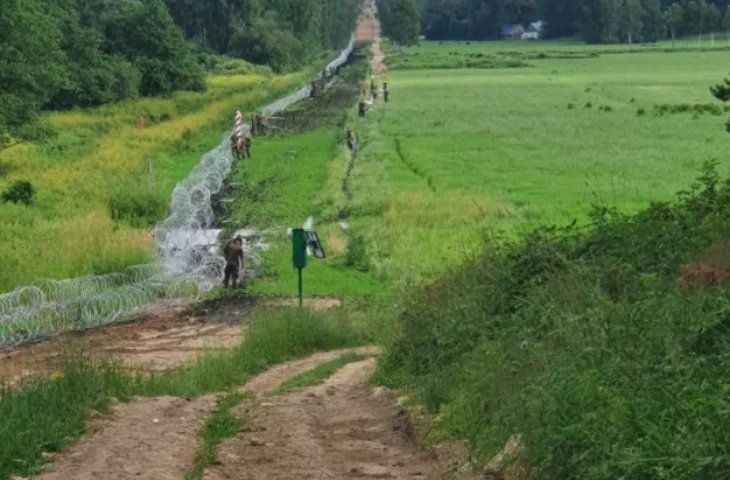A group of people from Afghanistan and Iraq have been nomadizing on Poland's border with Belarus for several days. In the open air they are waiting for help, which Poland refuses to give them. At the same time, the authorities are boasting about the installation of many kilometers of barbed wire entanglements on the eastern border. The infrastructure of exclusion clearly shows where Polish solidarity ends.
The crisis at the border has affected a group of several dozen people who most likely arrived in Poland after the Lukashenko regime opened channels for human smuggling. The Polish Border Guard not only refuses to let them enter Poland, but also prevents them from applying for international protection. The Ombudsman's Office is inquiring about the situation of people at the border. And while the situation is largely the result of deliberate action by the Belarusian regime, human rights and dignity must not be the victim of political manipulation.
The Polish military is sealing its borders with Belarus. I am in constant contact with commanders. Soldiers have already laid more than 100 kilometers of fencing on the border strip. They are also starting to lay another 50 km. pic.twitter.com/QGTVjcSOvJ
- Mariusz Blaszczak (@mblaszczak) August 19, 2021
wall on the border
At the same time as the ongoing situation on the border, in which an emaciated group of women, men, children (and one cat), are unable to get help from the European Union state, the Polish Army has begun sealing the border with Belarus. Barbed wire entanglements have appeared along a 100-kilometer stretch of the border strip to prevent people from entering Poland. The laying of another 50 km of fencing has also begun. The total length of Poland's border with Belarus is 418 kilometers, but the 187-kilometer section is the most "vulnerable to illegal crossing." The construction of obstacles on the border has encouraged national organizations to make even more far-reaching demands. The National Guard and the Independence March Association are calling for the construction of a wall "that will protect us from refugees." They also offer the military's volunteer assistance in erecting such a structure. However, the installation of barbed wire on the border will make it more difficult not only for refugees from the Far East to enter Poland, but also for Belarusians fleeing the repression of the Lukashenko regime.
A barrier not only to migration
photo: Mariusz Blaszczak - twitter
Poland's hitherto natural and open border is thus becoming its most heavily armed section, closing off the possibility of fleeing and seeking help inside the European Union. The gigantic infrastructure of exclusion closes the country of Solidarity to people who are used in the current political struggle, both domestically and internationally. Spatial barriers of this type are the ultimate and violent solution, which takes its toll on people, landscape and nature. For the migration routes of animals are also interrupted. A symbol of powerlessness in the face of a still small group of migrants, a stronger state and the European Union as a whole is, by the way, just one of many examples of installations of this type. Sometimes architects are also involved in their creation. This was the case, for example, with the wall on the US-Mexico border, where a number of official and conceptual competitions were held, including those against the idea of building a wall.
photo by Gary Goodenough
Calais fortress
However, the most famous European example of exclusionary infrastructure construction is the kilometers of white fencing financed by the UK and erected around the port of Calais, France. These were intended to prevent attempts to enter Britain through the port. Along the highway leading to the Channel Tunnel, there are more than 40 kilometers of fencing topped with coils of barbed wire.
photo by Alan Denney CC BY-NC-SA 2.0
The densely woven system of mesh panels repels attempts to cut or climb over. Along the road near the site of the former refugee camp is a four-meter-high concrete wall. The port is monitored, and trucks pass through scanners that can detect human heartbeats.
architecture of concern
But architecture can and should respond to the needs of the migrant crisis. And this, along with the climate crisis, will come sooner or later, amplified further by a new wave of migration from Afghanistan. A country plunged into war, in which Poland also took part, which makes our country co-responsible for the fate of its people and those seeking international assistance today and in the future. One example of the positive effect of architecture in this context can be seen, among others, in the interventionist housing center in Ivry-Sur-Seine. Designed by Atelier RITA, the complex offers 400 places in comfortable rooms of various sizes, sanitary facilities, yurt-style dining rooms, communal spaces including a medical center, four "integrated classrooms" for children and adults, and two more yurts serving as multipurpose rooms. In this project, the architects had to combine ease and speed of construction with the creation of a welcoming environment for those seeking help.
learning from experience
Photo: Wikimedia Commons
The migrant crisis is also the need to create spaces that are subject to constant change, expansion, based on simple techniques, but provide shelter for very different groups of people. The experience of the so-called "jungle" in Calais made it possible to develop a set of typologies for organizing camps corresponding to the cultures of the countries from which the refugees came. These were then used to design the urban layout of the La Liniere camp in Grande-Synthe near Dunkirk. The space was intended to give its residents a sense of community and humanize the typical structures associated with camps. You can read about the experience of the project, led by Actes et Cités and students from the Ecole Nationale Supérieure d'Architecture de Paris-Belleville, in the article "Planning a refugee camp," available on the Self-Portrait website.



























